Statistics for Business
VerifiedAdded on 2019/10/31
|10
|1325
|366
Report
AI Summary
The assignment content discusses statistics for business, including descriptive measures such as mean, median, mode, range, standard deviation, and variance. It also covers ANOVA and regression analysis to identify significant differences in start-up costs and predict annual sales based on various independent variables.
Contribute Materials
Your contribution can guide someone’s learning journey. Share your
documents today.
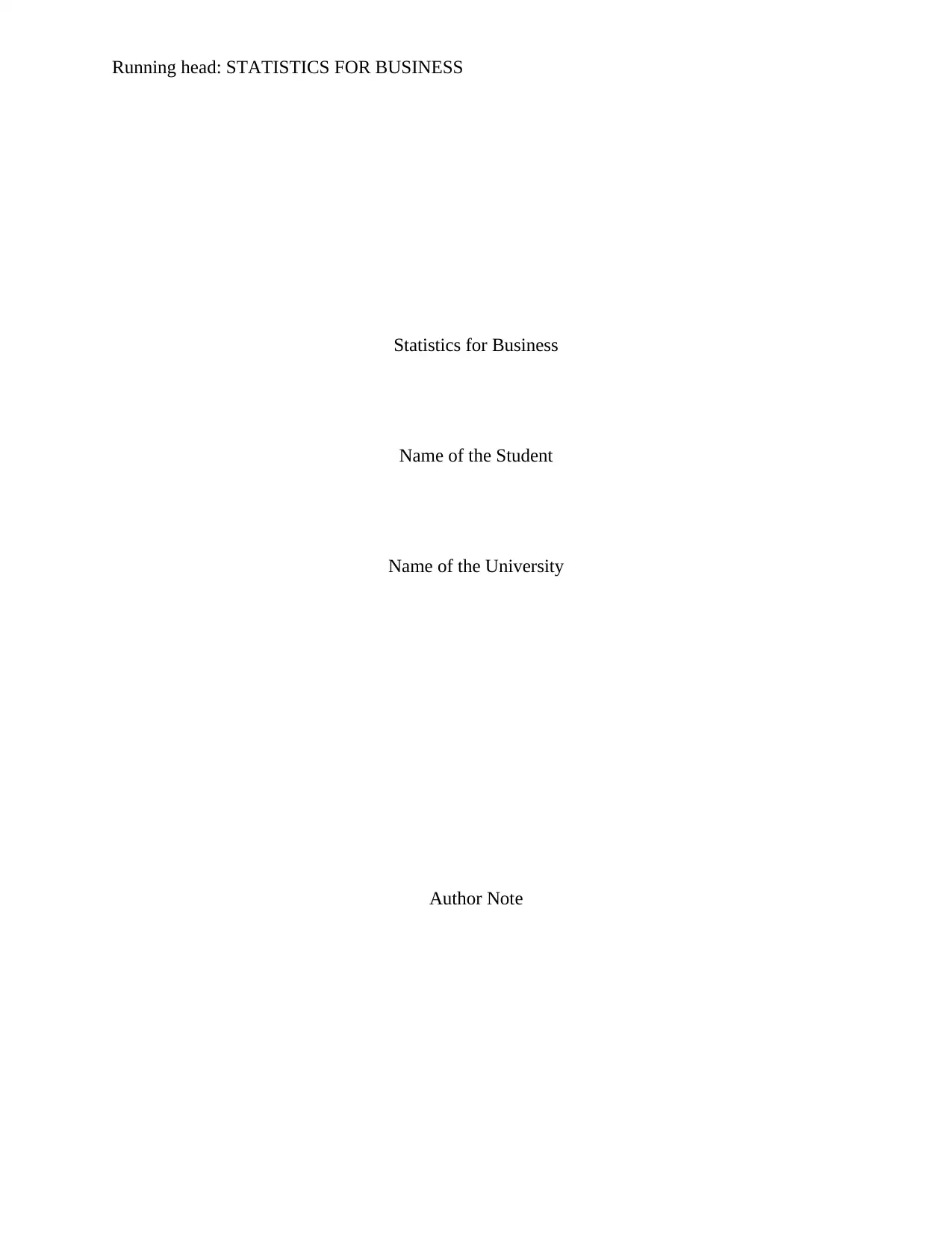
Running head: STATISTICS FOR BUSINESS
Statistics for Business
Name of the Student
Name of the University
Author Note
Statistics for Business
Name of the Student
Name of the University
Author Note
Secure Best Marks with AI Grader
Need help grading? Try our AI Grader for instant feedback on your assignments.
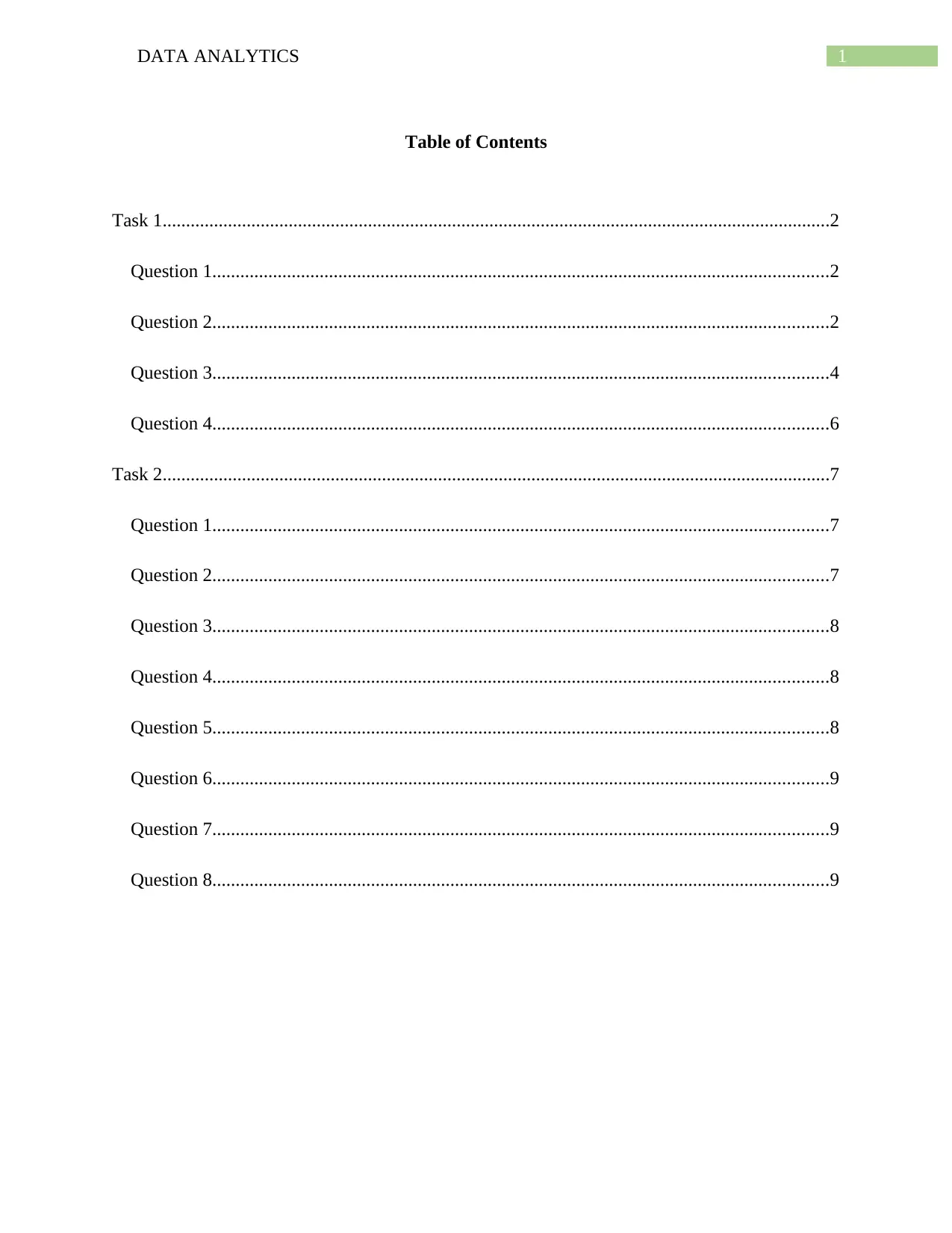
1DATA ANALYTICS
Table of Contents
Task 1...............................................................................................................................................2
Question 1....................................................................................................................................2
Question 2....................................................................................................................................2
Question 3....................................................................................................................................4
Question 4....................................................................................................................................6
Task 2...............................................................................................................................................7
Question 1....................................................................................................................................7
Question 2....................................................................................................................................7
Question 3....................................................................................................................................8
Question 4....................................................................................................................................8
Question 5....................................................................................................................................8
Question 6....................................................................................................................................9
Question 7....................................................................................................................................9
Question 8....................................................................................................................................9
Table of Contents
Task 1...............................................................................................................................................2
Question 1....................................................................................................................................2
Question 2....................................................................................................................................2
Question 3....................................................................................................................................4
Question 4....................................................................................................................................6
Task 2...............................................................................................................................................7
Question 1....................................................................................................................................7
Question 2....................................................................................................................................7
Question 3....................................................................................................................................8
Question 4....................................................................................................................................8
Question 5....................................................................................................................................8
Question 6....................................................................................................................................9
Question 7....................................................................................................................................9
Question 8....................................................................................................................................9
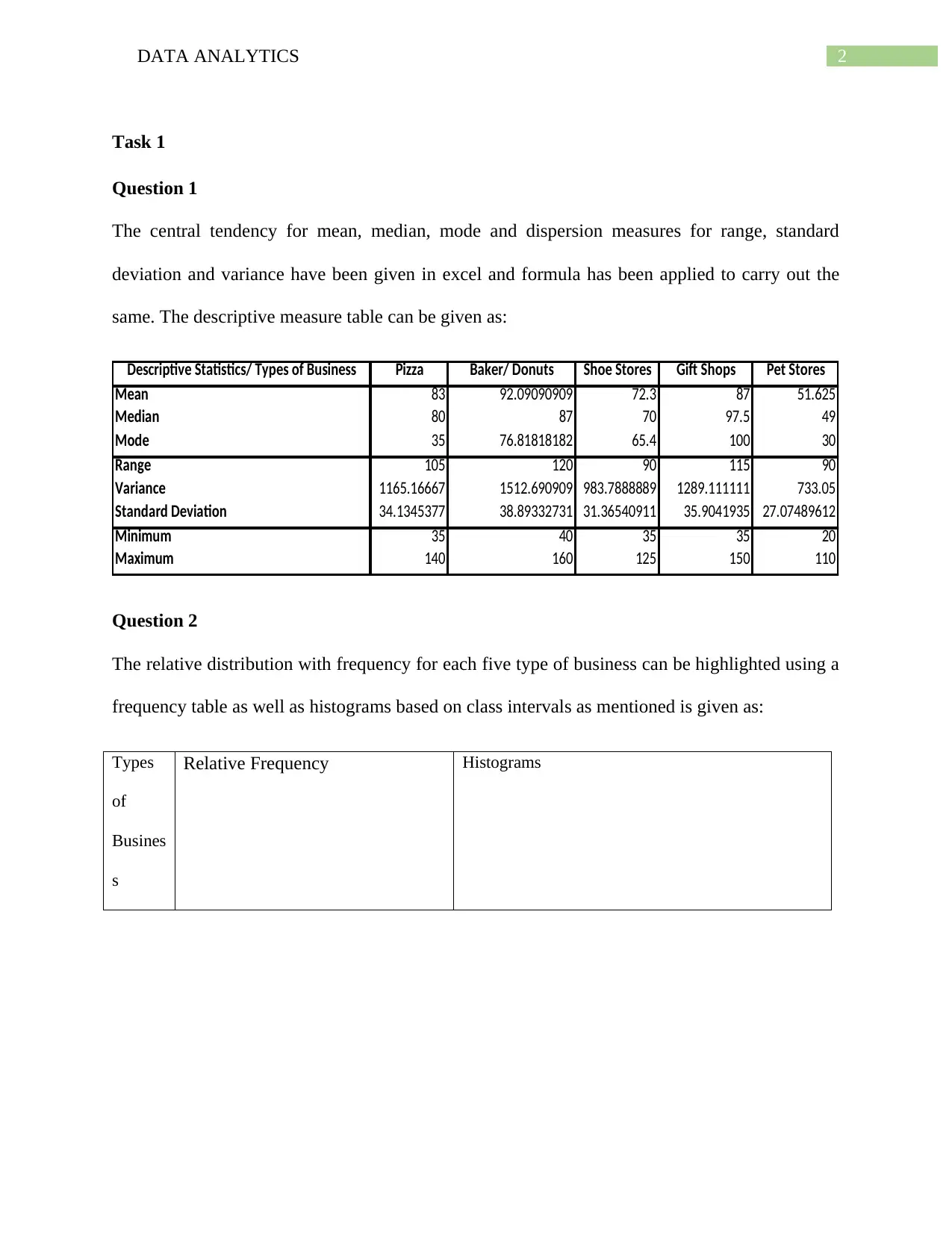
2DATA ANALYTICS
Task 1
Question 1
The central tendency for mean, median, mode and dispersion measures for range, standard
deviation and variance have been given in excel and formula has been applied to carry out the
same. The descriptive measure table can be given as:
Descriptive Statistics/ Types of Business Pizza Baker/ Donuts Shoe Stores Gift Shops Pet Stores
Mean 83 92.09090909 72.3 87 51.625
Median 80 87 70 97.5 49
Mode 35 76.81818182 65.4 100 30
Range 105 120 90 115 90
Variance 1165.16667 1512.690909 983.7888889 1289.111111 733.05
Standard Deviation 34.1345377 38.89332731 31.36540911 35.9041935 27.07489612
Minimum 35 40 35 35 20
Maximum 140 160 125 150 110
Question 2
The relative distribution with frequency for each five type of business can be highlighted using a
frequency table as well as histograms based on class intervals as mentioned is given as:
Types
of
Busines
s
Relative Frequency Histograms
Task 1
Question 1
The central tendency for mean, median, mode and dispersion measures for range, standard
deviation and variance have been given in excel and formula has been applied to carry out the
same. The descriptive measure table can be given as:
Descriptive Statistics/ Types of Business Pizza Baker/ Donuts Shoe Stores Gift Shops Pet Stores
Mean 83 92.09090909 72.3 87 51.625
Median 80 87 70 97.5 49
Mode 35 76.81818182 65.4 100 30
Range 105 120 90 115 90
Variance 1165.16667 1512.690909 983.7888889 1289.111111 733.05
Standard Deviation 34.1345377 38.89332731 31.36540911 35.9041935 27.07489612
Minimum 35 40 35 35 20
Maximum 140 160 125 150 110
Question 2
The relative distribution with frequency for each five type of business can be highlighted using a
frequency table as well as histograms based on class intervals as mentioned is given as:
Types
of
Busines
s
Relative Frequency Histograms
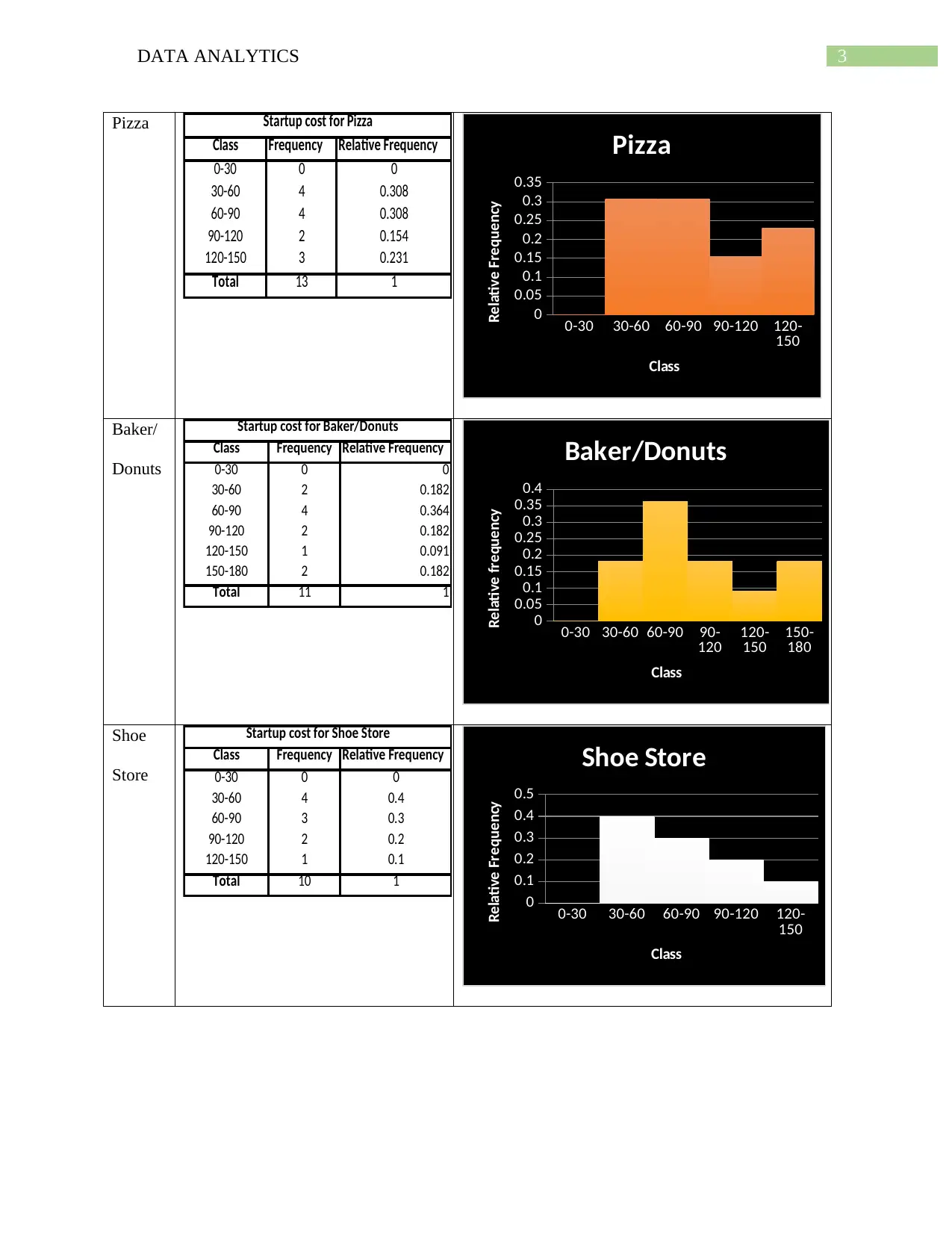
3DATA ANALYTICS
Pizza
Class Frequency Relative Frequency
0-30 0 0
30-60 4 0.308
60-90 4 0.308
90-120 2 0.154
120-150 3 0.231
Total 13 1
Startup cost for Pizza
0-30 30-60 60-90 90-120 120-
150
0
0.05
0.1
0.15
0.2
0.25
0.3
0.35
Pizza
Class
Relative Frequency
Baker/
Donuts
Class Frequency Relative Frequency
0-30 0 0
30-60 2 0.182
60-90 4 0.364
90-120 2 0.182
120-150 1 0.091
150-180 2 0.182
Total 11 1
Startup cost for Baker/Donuts
0-30 30-60 60-90 90-
120 120-
150 150-
180
0
0.05
0.1
0.15
0.2
0.25
0.3
0.35
0.4
Baker/Donuts
Class
Relative frequency
Shoe
Store
Class Frequency Relative Frequency
0-30 0 0
30-60 4 0.4
60-90 3 0.3
90-120 2 0.2
120-150 1 0.1
Total 10 1
Startup cost for Shoe Store
0-30 30-60 60-90 90-120 120-
150
0
0.1
0.2
0.3
0.4
0.5
Shoe Store
Class
Relative Frequency
Pizza
Class Frequency Relative Frequency
0-30 0 0
30-60 4 0.308
60-90 4 0.308
90-120 2 0.154
120-150 3 0.231
Total 13 1
Startup cost for Pizza
0-30 30-60 60-90 90-120 120-
150
0
0.05
0.1
0.15
0.2
0.25
0.3
0.35
Pizza
Class
Relative Frequency
Baker/
Donuts
Class Frequency Relative Frequency
0-30 0 0
30-60 2 0.182
60-90 4 0.364
90-120 2 0.182
120-150 1 0.091
150-180 2 0.182
Total 11 1
Startup cost for Baker/Donuts
0-30 30-60 60-90 90-
120 120-
150 150-
180
0
0.05
0.1
0.15
0.2
0.25
0.3
0.35
0.4
Baker/Donuts
Class
Relative frequency
Shoe
Store
Class Frequency Relative Frequency
0-30 0 0
30-60 4 0.4
60-90 3 0.3
90-120 2 0.2
120-150 1 0.1
Total 10 1
Startup cost for Shoe Store
0-30 30-60 60-90 90-120 120-
150
0
0.1
0.2
0.3
0.4
0.5
Shoe Store
Class
Relative Frequency
Secure Best Marks with AI Grader
Need help grading? Try our AI Grader for instant feedback on your assignments.
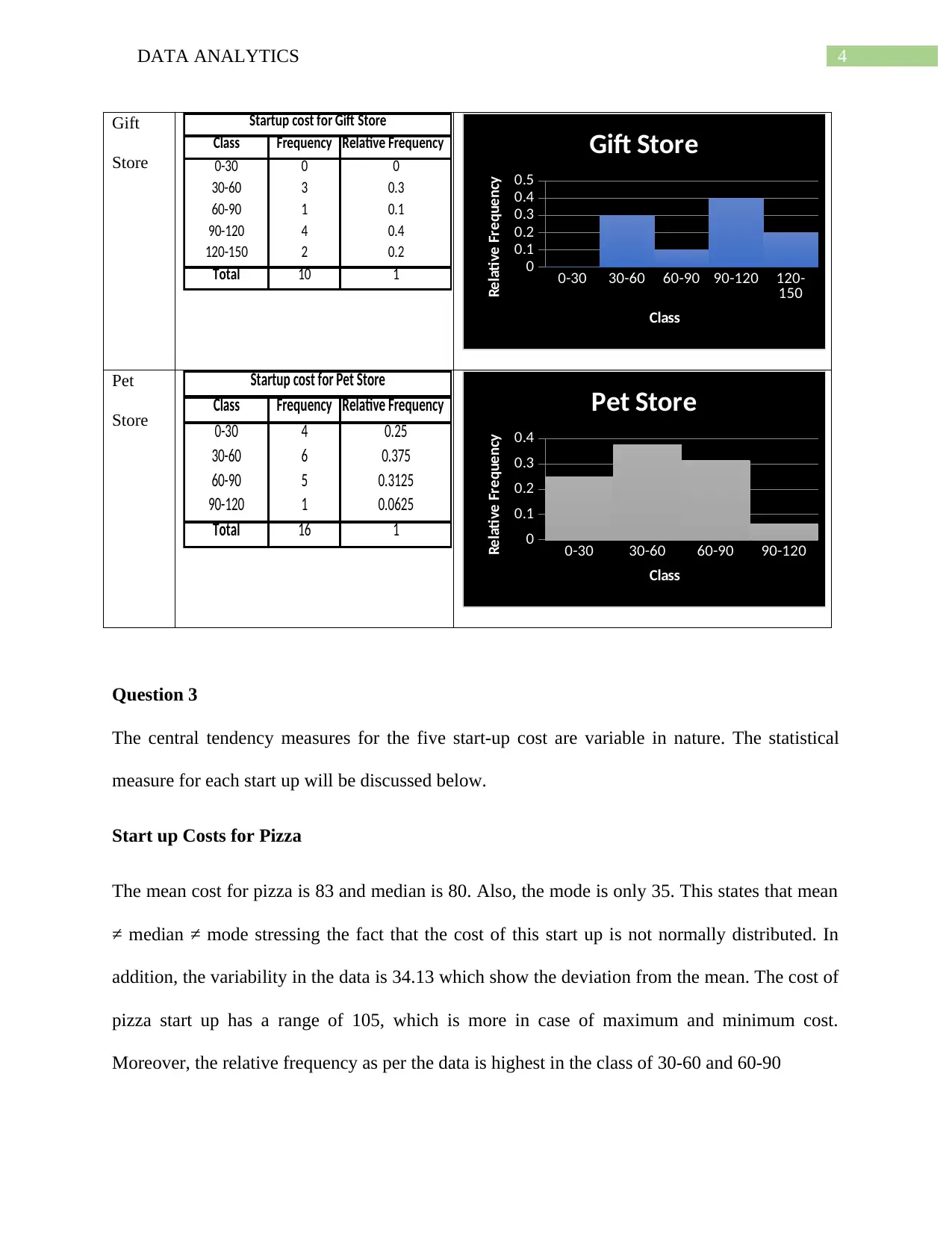
4DATA ANALYTICS
Gift
Store
Class Frequency Relative Frequency
0-30 0 0
30-60 3 0.3
60-90 1 0.1
90-120 4 0.4
120-150 2 0.2
Total 10 1
Startup cost for Gift Store
0-30 30-60 60-90 90-120 120-
150
0
0.1
0.2
0.3
0.4
0.5
Gift Store
Class
Relative Frequency
Pet
Store Class Frequency Relative Frequency
0-30 4 0.25
30-60 6 0.375
60-90 5 0.3125
90-120 1 0.0625
Total 16 1
Startup cost for Pet Store
0-30 30-60 60-90 90-120
0
0.1
0.2
0.3
0.4
Pet Store
Class
Relative Frequency
Question 3
The central tendency measures for the five start-up cost are variable in nature. The statistical
measure for each start up will be discussed below.
Start up Costs for Pizza
The mean cost for pizza is 83 and median is 80. Also, the mode is only 35. This states that mean
≠ median ≠ mode stressing the fact that the cost of this start up is not normally distributed. In
addition, the variability in the data is 34.13 which show the deviation from the mean. The cost of
pizza start up has a range of 105, which is more in case of maximum and minimum cost.
Moreover, the relative frequency as per the data is highest in the class of 30-60 and 60-90
Gift
Store
Class Frequency Relative Frequency
0-30 0 0
30-60 3 0.3
60-90 1 0.1
90-120 4 0.4
120-150 2 0.2
Total 10 1
Startup cost for Gift Store
0-30 30-60 60-90 90-120 120-
150
0
0.1
0.2
0.3
0.4
0.5
Gift Store
Class
Relative Frequency
Pet
Store Class Frequency Relative Frequency
0-30 4 0.25
30-60 6 0.375
60-90 5 0.3125
90-120 1 0.0625
Total 16 1
Startup cost for Pet Store
0-30 30-60 60-90 90-120
0
0.1
0.2
0.3
0.4
Pet Store
Class
Relative Frequency
Question 3
The central tendency measures for the five start-up cost are variable in nature. The statistical
measure for each start up will be discussed below.
Start up Costs for Pizza
The mean cost for pizza is 83 and median is 80. Also, the mode is only 35. This states that mean
≠ median ≠ mode stressing the fact that the cost of this start up is not normally distributed. In
addition, the variability in the data is 34.13 which show the deviation from the mean. The cost of
pizza start up has a range of 105, which is more in case of maximum and minimum cost.
Moreover, the relative frequency as per the data is highest in the class of 30-60 and 60-90
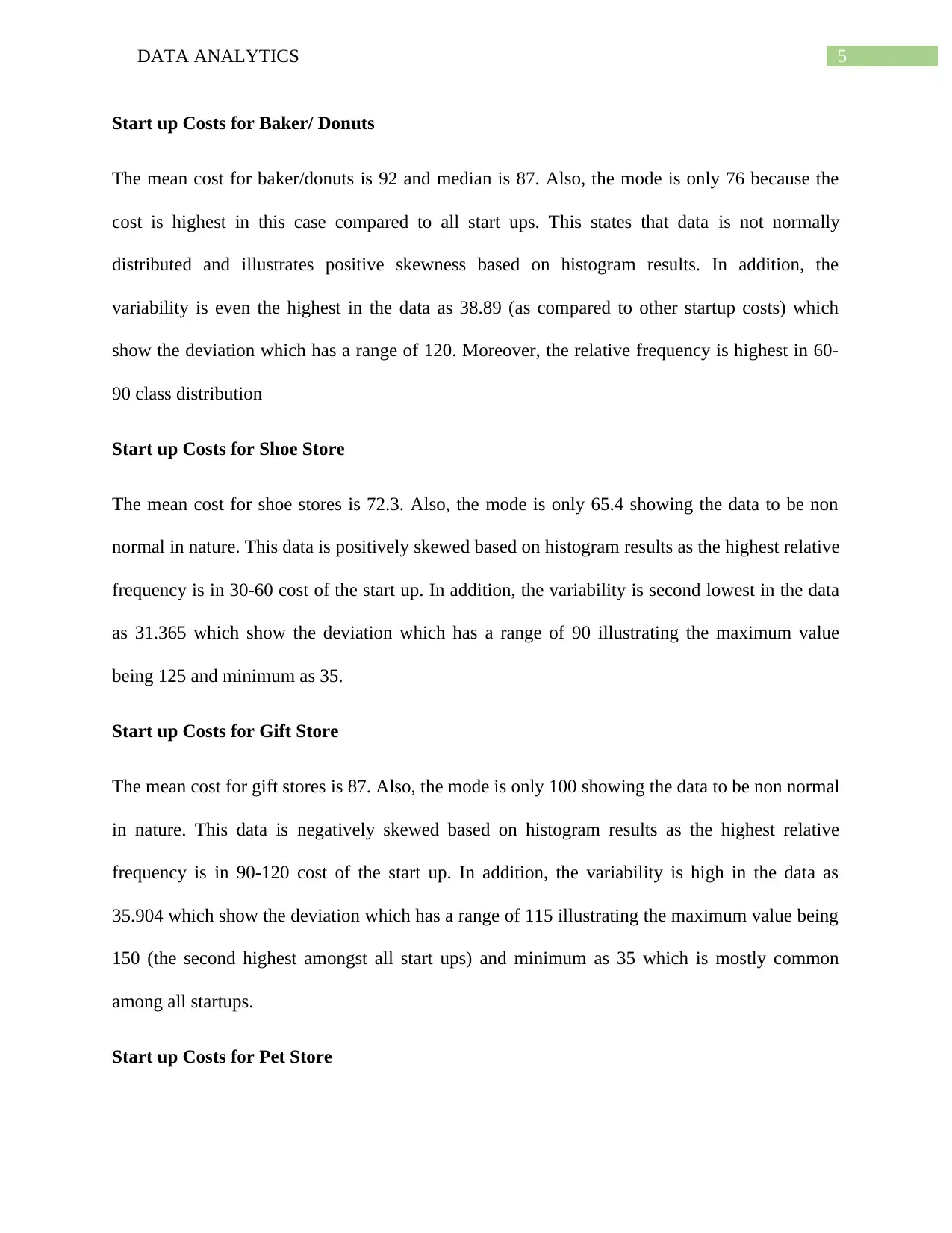
5DATA ANALYTICS
Start up Costs for Baker/ Donuts
The mean cost for baker/donuts is 92 and median is 87. Also, the mode is only 76 because the
cost is highest in this case compared to all start ups. This states that data is not normally
distributed and illustrates positive skewness based on histogram results. In addition, the
variability is even the highest in the data as 38.89 (as compared to other startup costs) which
show the deviation which has a range of 120. Moreover, the relative frequency is highest in 60-
90 class distribution
Start up Costs for Shoe Store
The mean cost for shoe stores is 72.3. Also, the mode is only 65.4 showing the data to be non
normal in nature. This data is positively skewed based on histogram results as the highest relative
frequency is in 30-60 cost of the start up. In addition, the variability is second lowest in the data
as 31.365 which show the deviation which has a range of 90 illustrating the maximum value
being 125 and minimum as 35.
Start up Costs for Gift Store
The mean cost for gift stores is 87. Also, the mode is only 100 showing the data to be non normal
in nature. This data is negatively skewed based on histogram results as the highest relative
frequency is in 90-120 cost of the start up. In addition, the variability is high in the data as
35.904 which show the deviation which has a range of 115 illustrating the maximum value being
150 (the second highest amongst all start ups) and minimum as 35 which is mostly common
among all startups.
Start up Costs for Pet Store
Start up Costs for Baker/ Donuts
The mean cost for baker/donuts is 92 and median is 87. Also, the mode is only 76 because the
cost is highest in this case compared to all start ups. This states that data is not normally
distributed and illustrates positive skewness based on histogram results. In addition, the
variability is even the highest in the data as 38.89 (as compared to other startup costs) which
show the deviation which has a range of 120. Moreover, the relative frequency is highest in 60-
90 class distribution
Start up Costs for Shoe Store
The mean cost for shoe stores is 72.3. Also, the mode is only 65.4 showing the data to be non
normal in nature. This data is positively skewed based on histogram results as the highest relative
frequency is in 30-60 cost of the start up. In addition, the variability is second lowest in the data
as 31.365 which show the deviation which has a range of 90 illustrating the maximum value
being 125 and minimum as 35.
Start up Costs for Gift Store
The mean cost for gift stores is 87. Also, the mode is only 100 showing the data to be non normal
in nature. This data is negatively skewed based on histogram results as the highest relative
frequency is in 90-120 cost of the start up. In addition, the variability is high in the data as
35.904 which show the deviation which has a range of 115 illustrating the maximum value being
150 (the second highest amongst all start ups) and minimum as 35 which is mostly common
among all startups.
Start up Costs for Pet Store
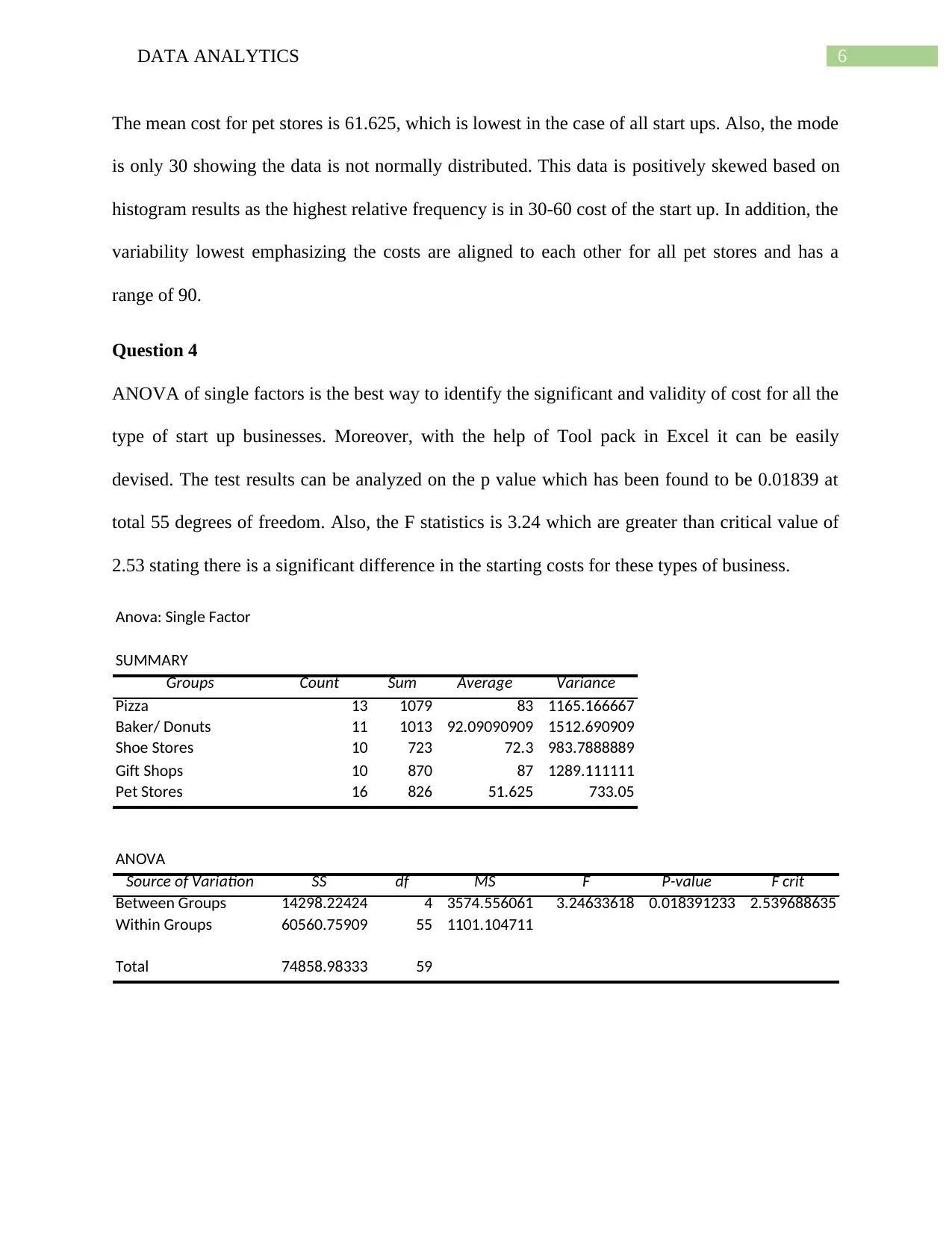
6DATA ANALYTICS
The mean cost for pet stores is 61.625, which is lowest in the case of all start ups. Also, the mode
is only 30 showing the data is not normally distributed. This data is positively skewed based on
histogram results as the highest relative frequency is in 30-60 cost of the start up. In addition, the
variability lowest emphasizing the costs are aligned to each other for all pet stores and has a
range of 90.
Question 4
ANOVA of single factors is the best way to identify the significant and validity of cost for all the
type of start up businesses. Moreover, with the help of Tool pack in Excel it can be easily
devised. The test results can be analyzed on the p value which has been found to be 0.01839 at
total 55 degrees of freedom. Also, the F statistics is 3.24 which are greater than critical value of
2.53 stating there is a significant difference in the starting costs for these types of business.
Anova: Single Factor
SUMMARY
Groups Count Sum Average Variance
Pizza 13 1079 83 1165.166667
Baker/ Donuts 11 1013 92.09090909 1512.690909
Shoe Stores 10 723 72.3 983.7888889
Gift Shops 10 870 87 1289.111111
Pet Stores 16 826 51.625 733.05
ANOVA
Source of Variation SS df MS F P-value F crit
Between Groups 14298.22424 4 3574.556061 3.24633618 0.018391233 2.539688635
Within Groups 60560.75909 55 1101.104711
Total 74858.98333 59
The mean cost for pet stores is 61.625, which is lowest in the case of all start ups. Also, the mode
is only 30 showing the data is not normally distributed. This data is positively skewed based on
histogram results as the highest relative frequency is in 30-60 cost of the start up. In addition, the
variability lowest emphasizing the costs are aligned to each other for all pet stores and has a
range of 90.
Question 4
ANOVA of single factors is the best way to identify the significant and validity of cost for all the
type of start up businesses. Moreover, with the help of Tool pack in Excel it can be easily
devised. The test results can be analyzed on the p value which has been found to be 0.01839 at
total 55 degrees of freedom. Also, the F statistics is 3.24 which are greater than critical value of
2.53 stating there is a significant difference in the starting costs for these types of business.
Anova: Single Factor
SUMMARY
Groups Count Sum Average Variance
Pizza 13 1079 83 1165.166667
Baker/ Donuts 11 1013 92.09090909 1512.690909
Shoe Stores 10 723 72.3 983.7888889
Gift Shops 10 870 87 1289.111111
Pet Stores 16 826 51.625 733.05
ANOVA
Source of Variation SS df MS F P-value F crit
Between Groups 14298.22424 4 3574.556061 3.24633618 0.018391233 2.539688635
Within Groups 60560.75909 55 1101.104711
Total 74858.98333 59
Paraphrase This Document
Need a fresh take? Get an instant paraphrase of this document with our AI Paraphraser
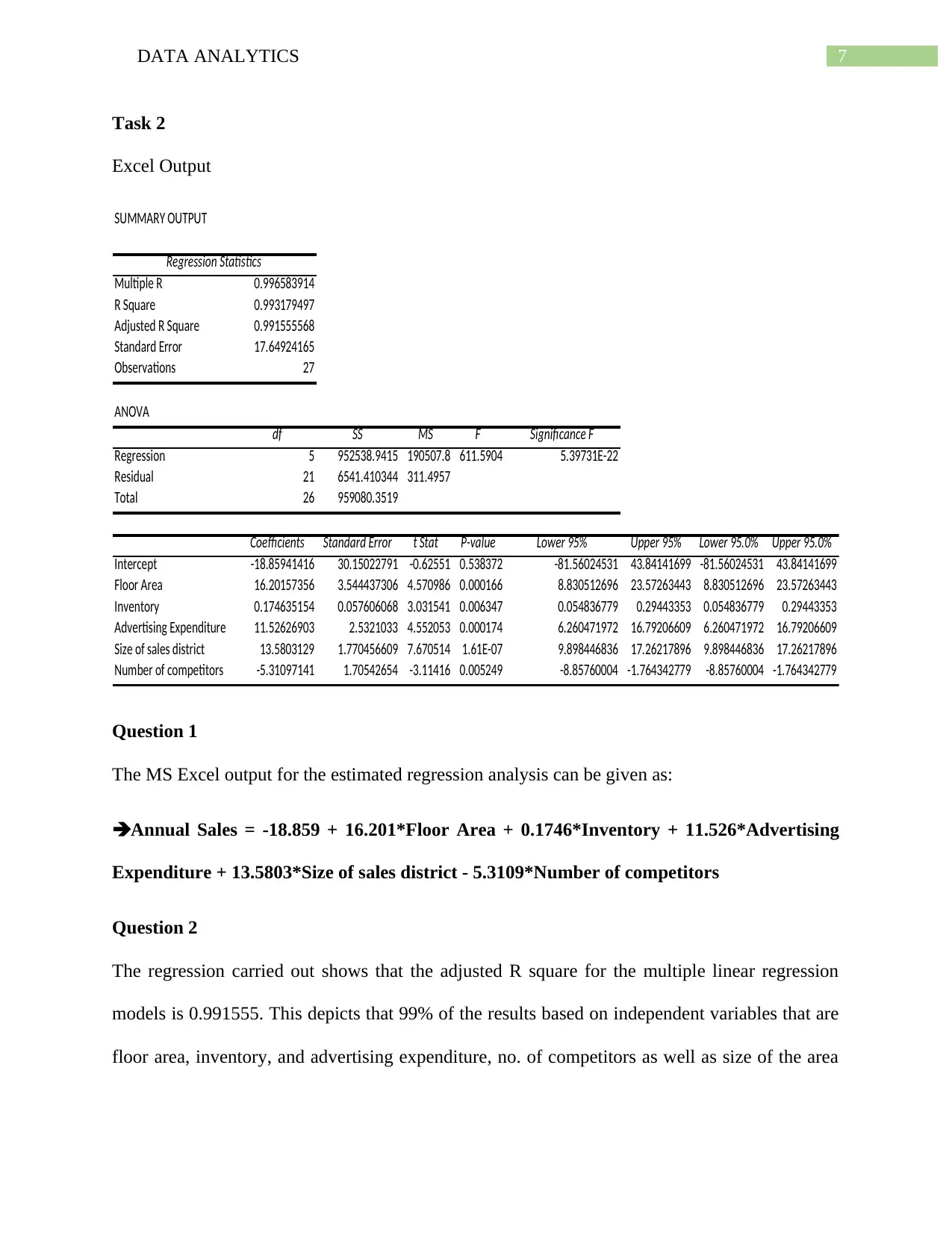
7DATA ANALYTICS
Task 2
Excel Output
SUMMARY OUTPUT
Regression Statistics
Multiple R 0.996583914
R Square 0.993179497
Adjusted R Square 0.991555568
Standard Error 17.64924165
Observations 27
ANOVA
df SS MS F Significance F
Regression 5 952538.9415 190507.8 611.5904 5.39731E-22
Residual 21 6541.410344 311.4957
Total 26 959080.3519
Coefficients Standard Error t Stat P-value Lower 95% Upper 95% Lower 95.0% Upper 95.0%
Intercept -18.85941416 30.15022791 -0.62551 0.538372 -81.56024531 43.84141699 -81.56024531 43.84141699
Floor Area 16.20157356 3.544437306 4.570986 0.000166 8.830512696 23.57263443 8.830512696 23.57263443
Inventory 0.174635154 0.057606068 3.031541 0.006347 0.054836779 0.29443353 0.054836779 0.29443353
Advertising Expenditure 11.52626903 2.5321033 4.552053 0.000174 6.260471972 16.79206609 6.260471972 16.79206609
Size of sales district 13.5803129 1.770456609 7.670514 1.61E-07 9.898446836 17.26217896 9.898446836 17.26217896
Number of competitors -5.31097141 1.70542654 -3.11416 0.005249 -8.85760004 -1.764342779 -8.85760004 -1.764342779
Question 1
The MS Excel output for the estimated regression analysis can be given as:
Annual Sales = -18.859 + 16.201*Floor Area + 0.1746*Inventory + 11.526*Advertising
Expenditure + 13.5803*Size of sales district - 5.3109*Number of competitors
Question 2
The regression carried out shows that the adjusted R square for the multiple linear regression
models is 0.991555. This depicts that 99% of the results based on independent variables that are
floor area, inventory, and advertising expenditure, no. of competitors as well as size of the area
Task 2
Excel Output
SUMMARY OUTPUT
Regression Statistics
Multiple R 0.996583914
R Square 0.993179497
Adjusted R Square 0.991555568
Standard Error 17.64924165
Observations 27
ANOVA
df SS MS F Significance F
Regression 5 952538.9415 190507.8 611.5904 5.39731E-22
Residual 21 6541.410344 311.4957
Total 26 959080.3519
Coefficients Standard Error t Stat P-value Lower 95% Upper 95% Lower 95.0% Upper 95.0%
Intercept -18.85941416 30.15022791 -0.62551 0.538372 -81.56024531 43.84141699 -81.56024531 43.84141699
Floor Area 16.20157356 3.544437306 4.570986 0.000166 8.830512696 23.57263443 8.830512696 23.57263443
Inventory 0.174635154 0.057606068 3.031541 0.006347 0.054836779 0.29443353 0.054836779 0.29443353
Advertising Expenditure 11.52626903 2.5321033 4.552053 0.000174 6.260471972 16.79206609 6.260471972 16.79206609
Size of sales district 13.5803129 1.770456609 7.670514 1.61E-07 9.898446836 17.26217896 9.898446836 17.26217896
Number of competitors -5.31097141 1.70542654 -3.11416 0.005249 -8.85760004 -1.764342779 -8.85760004 -1.764342779
Question 1
The MS Excel output for the estimated regression analysis can be given as:
Annual Sales = -18.859 + 16.201*Floor Area + 0.1746*Inventory + 11.526*Advertising
Expenditure + 13.5803*Size of sales district - 5.3109*Number of competitors
Question 2
The regression carried out shows that the adjusted R square for the multiple linear regression
models is 0.991555. This depicts that 99% of the results based on independent variables that are
floor area, inventory, and advertising expenditure, no. of competitors as well as size of the area
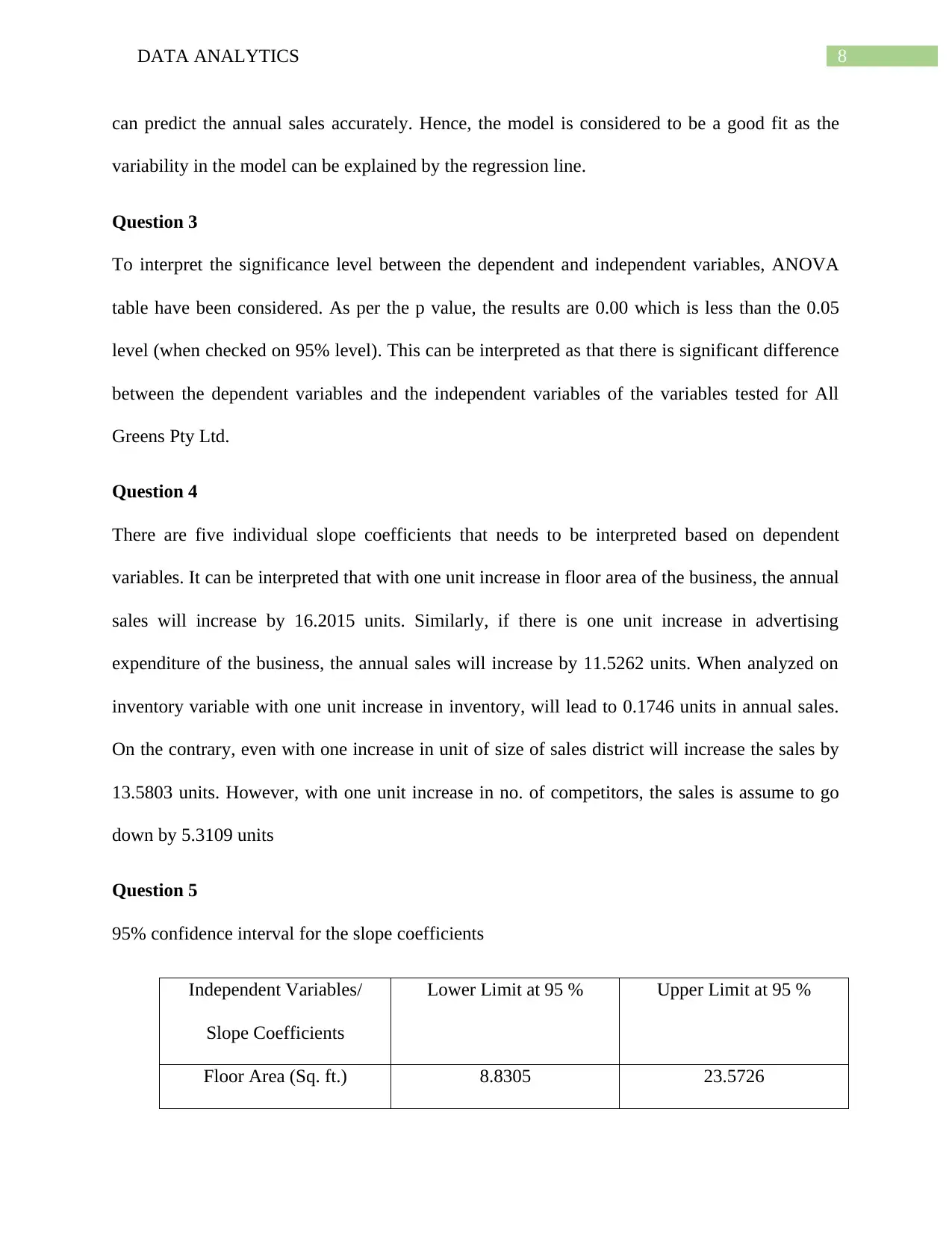
8DATA ANALYTICS
can predict the annual sales accurately. Hence, the model is considered to be a good fit as the
variability in the model can be explained by the regression line.
Question 3
To interpret the significance level between the dependent and independent variables, ANOVA
table have been considered. As per the p value, the results are 0.00 which is less than the 0.05
level (when checked on 95% level). This can be interpreted as that there is significant difference
between the dependent variables and the independent variables of the variables tested for All
Greens Pty Ltd.
Question 4
There are five individual slope coefficients that needs to be interpreted based on dependent
variables. It can be interpreted that with one unit increase in floor area of the business, the annual
sales will increase by 16.2015 units. Similarly, if there is one unit increase in advertising
expenditure of the business, the annual sales will increase by 11.5262 units. When analyzed on
inventory variable with one unit increase in inventory, will lead to 0.1746 units in annual sales.
On the contrary, even with one increase in unit of size of sales district will increase the sales by
13.5803 units. However, with one unit increase in no. of competitors, the sales is assume to go
down by 5.3109 units
Question 5
95% confidence interval for the slope coefficients
Independent Variables/
Slope Coefficients
Lower Limit at 95 % Upper Limit at 95 %
Floor Area (Sq. ft.) 8.8305 23.5726
can predict the annual sales accurately. Hence, the model is considered to be a good fit as the
variability in the model can be explained by the regression line.
Question 3
To interpret the significance level between the dependent and independent variables, ANOVA
table have been considered. As per the p value, the results are 0.00 which is less than the 0.05
level (when checked on 95% level). This can be interpreted as that there is significant difference
between the dependent variables and the independent variables of the variables tested for All
Greens Pty Ltd.
Question 4
There are five individual slope coefficients that needs to be interpreted based on dependent
variables. It can be interpreted that with one unit increase in floor area of the business, the annual
sales will increase by 16.2015 units. Similarly, if there is one unit increase in advertising
expenditure of the business, the annual sales will increase by 11.5262 units. When analyzed on
inventory variable with one unit increase in inventory, will lead to 0.1746 units in annual sales.
On the contrary, even with one increase in unit of size of sales district will increase the sales by
13.5803 units. However, with one unit increase in no. of competitors, the sales is assume to go
down by 5.3109 units
Question 5
95% confidence interval for the slope coefficients
Independent Variables/
Slope Coefficients
Lower Limit at 95 % Upper Limit at 95 %
Floor Area (Sq. ft.) 8.8305 23.5726
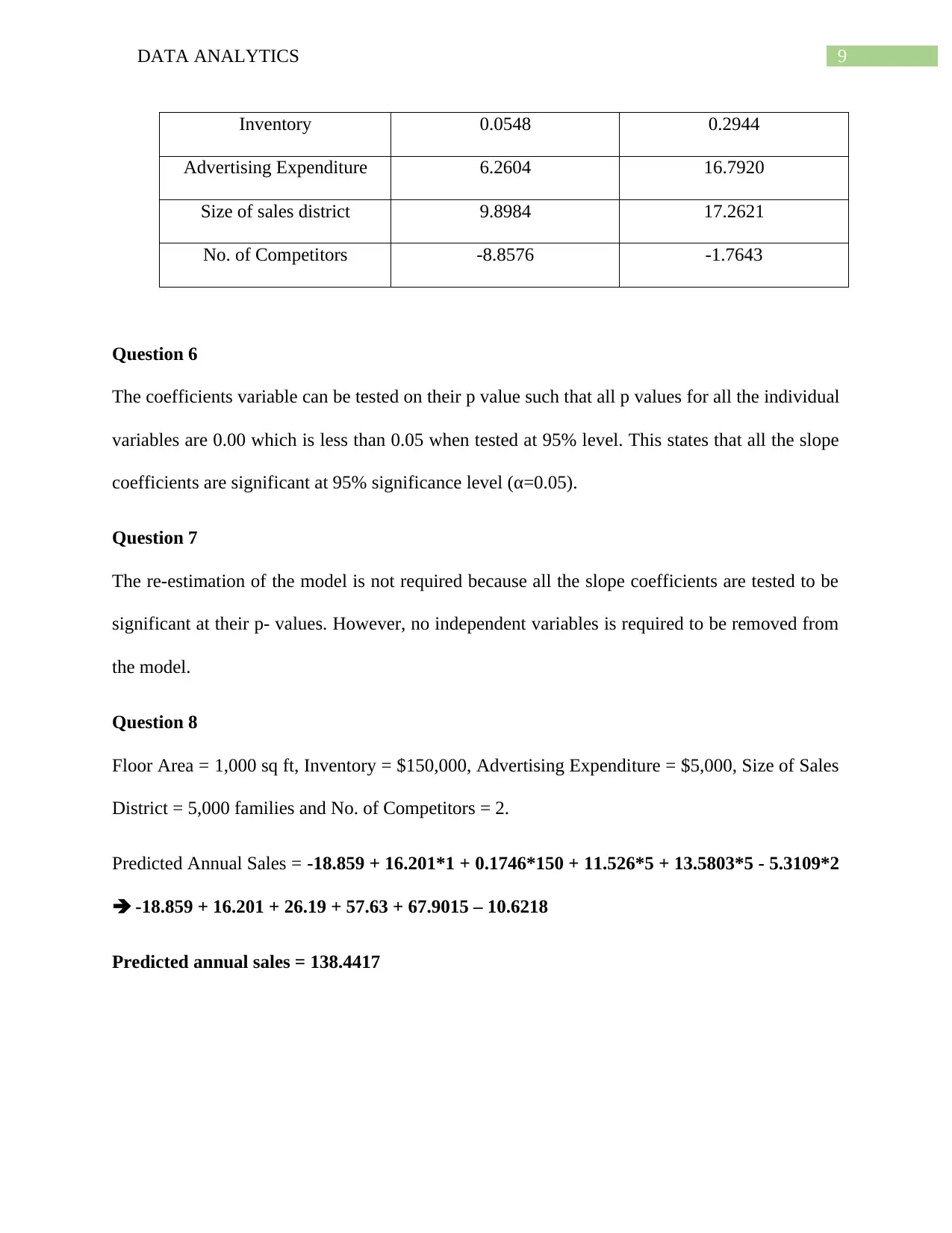
9DATA ANALYTICS
Inventory 0.0548 0.2944
Advertising Expenditure 6.2604 16.7920
Size of sales district 9.8984 17.2621
No. of Competitors -8.8576 -1.7643
Question 6
The coefficients variable can be tested on their p value such that all p values for all the individual
variables are 0.00 which is less than 0.05 when tested at 95% level. This states that all the slope
coefficients are significant at 95% significance level (α=0.05).
Question 7
The re-estimation of the model is not required because all the slope coefficients are tested to be
significant at their p- values. However, no independent variables is required to be removed from
the model.
Question 8
Floor Area = 1,000 sq ft, Inventory = $150,000, Advertising Expenditure = $5,000, Size of Sales
District = 5,000 families and No. of Competitors = 2.
Predicted Annual Sales = -18.859 + 16.201*1 + 0.1746*150 + 11.526*5 + 13.5803*5 - 5.3109*2
-18.859 + 16.201 + 26.19 + 57.63 + 67.9015 – 10.6218
Predicted annual sales = 138.4417
Inventory 0.0548 0.2944
Advertising Expenditure 6.2604 16.7920
Size of sales district 9.8984 17.2621
No. of Competitors -8.8576 -1.7643
Question 6
The coefficients variable can be tested on their p value such that all p values for all the individual
variables are 0.00 which is less than 0.05 when tested at 95% level. This states that all the slope
coefficients are significant at 95% significance level (α=0.05).
Question 7
The re-estimation of the model is not required because all the slope coefficients are tested to be
significant at their p- values. However, no independent variables is required to be removed from
the model.
Question 8
Floor Area = 1,000 sq ft, Inventory = $150,000, Advertising Expenditure = $5,000, Size of Sales
District = 5,000 families and No. of Competitors = 2.
Predicted Annual Sales = -18.859 + 16.201*1 + 0.1746*150 + 11.526*5 + 13.5803*5 - 5.3109*2
-18.859 + 16.201 + 26.19 + 57.63 + 67.9015 – 10.6218
Predicted annual sales = 138.4417
1 out of 10
Related Documents
Your All-in-One AI-Powered Toolkit for Academic Success.
+13062052269
info@desklib.com
Available 24*7 on WhatsApp / Email
![[object Object]](/_next/static/media/star-bottom.7253800d.svg)
Unlock your academic potential
© 2024 | Zucol Services PVT LTD | All rights reserved.





